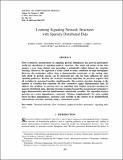Learning signaling network structures with sparsely distributed data
Author(s)
Sachs, Karen; Itani, Solomon; Carlisle, Jennifer; Nolan, Garry P.; Pe'er, Dana; Lauffenburger, Douglas A.; ... Show more Show less
DownloadLauffenburger_Learning Signaling cmb.2008.07TT.pdf (415.4Kb)
PUBLISHER_POLICY
Publisher Policy
Article is made available in accordance with the publisher's policy and may be subject to US copyright law. Please refer to the publisher's site for terms of use.
Terms of use
Metadata
Show full item recordAbstract
Flow cytometric measurement of signaling protein abundances has proved particularly useful for elucidation of signaling pathway structure. The single cell nature of the data ensures a very large dataset size, providing a statistically robust dataset for structure learning. Moreover, the approach is easily scaled to many conditions in high throughput. However, the technology suffers from a dimensionality constraint: at the cutting edge, only about 12 protein species can be measured per cell, far from sufficient for most signaling pathways. Because the structure learning algorithm (in practice) requires that all variables be measured together simultaneously, this restricts structure learning to the number of variables that constitute the flow cytometer's upper dimensionality limit. To address this problem, we present here an algorithm that enables structure learning for sparsely distributed data, allowing structure learning beyond the measurement technology's upper dimensionality limit for simultaneously measurable variables. The algorithm assesses pairwise (or n-wise) dependencies, constructs “Markov neighborhoods” for each variable based on these dependencies, measures each variable in the context of its neighborhood, and performs structure learning using a constrained search.
Date issued
2009-02Department
Massachusetts Institute of Technology. Department of Biological Engineering; Massachusetts Institute of Technology. Department of Electrical Engineering and Computer ScienceJournal
Journal of Computational Biology
Publisher
Mary Ann Liebert, Inc.
Citation
Sachs, Karen et al. “Learning Signaling Network Structures with Sparsely Distributed Data.” Journal of Computational Biology 16.2 (2010): 201-212. © 2009 Mary Ann Liebert, Inc.
Version: Final published version
ISSN
1066-5277
1557-8666